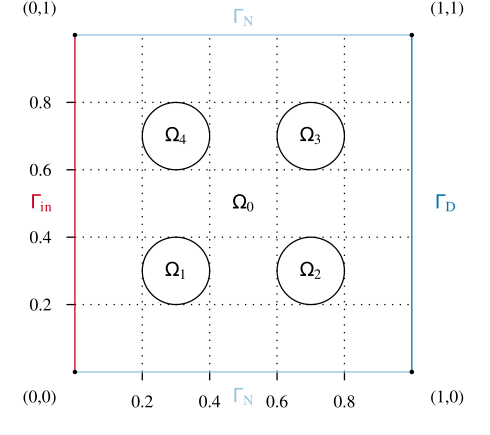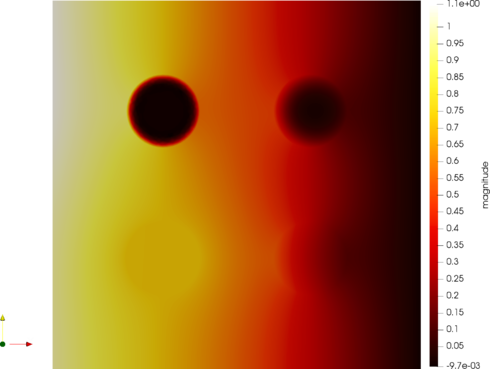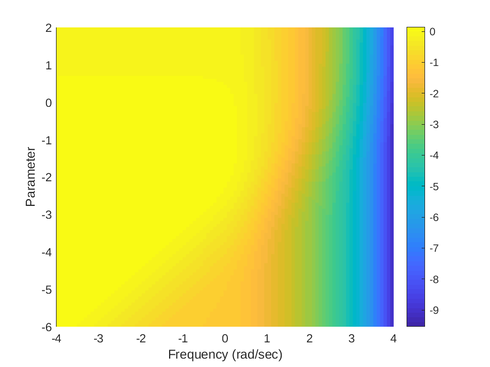 Note: This page has not been verified by our editors.
Note: This page has not been verified by our editors.
Description
A parametric semi-discretized heat transfer problem with varying heat transfer coefficients, the parameters, on subdomains.
Modeling
Consider a parameter ![\mu\in{[10^{-6},10^2]}^4\subset\mathbb{R}^{4}](/morwiki/images/math/b/0/5/b055bfc56b41ae34dc4343ace56270d7.png) and define the heat conductivity
and define the heat conductivity  as
as  when
when  and
and  when
when  . The heat distribution is governed by the equation:
. The heat distribution is governed by the equation:
with a heat-inflow condition on the left
perfect isolation on the top and bottom
and fixed temperature on the right
and initial condition
Discretization
For the discretization, FENICS 2019.1 was used on a simplicial grid with first order elements. The mesh is generated from the domain specification using gmsh 3.0.6 with 'clscale' set to  . The python based source code for the discretization can be found at Zenodo.
. The python based source code for the discretization can be found at Zenodo.
Origin
This benchmark was developed for the MODRED 2019 proceedings.
Data
The benchmark includes the basic domain description as a gmsh input file, Python scripts for the matrix assembly, simulation in pyMOR and visualization as VTK, together with the matrices both as one combined file ABCE.mat or separate matrix market files for all matrices. The sources and the ABCE.mat are available for download at Zenodo.
Note that the heat transfer coefficients are designed as characteristic functions on the domains, such that the system is only well-posed when all entries in  are positive.
are positive.
Dimensions
System structure:
System dimensions:
 ,
,
 ,
,
 ,
,
 ,
,
 ,
,
 ,
,
 ,
,
 ,
,
where  for the system matrices given in
for the system matrices given in ABCE.mat.
Variants
Besides the full four parameter setup, the model can be used in variations with other numbers of independent parameters. The following two are recommended in the original work and have been investigated in the literature[1],[2],[3].
Single parameter
The interpretation of the thermal block as the "cookie backing" problem with slight variation in the dough leads to an easy one parameter variant. Here the new single parameter ![\hat\mu\in [ 10^{-6}, 10^2]](/morwiki/images/math/7/8/e/78e442ccec98fe42c3cfe7078f053362.png) is chosen such that
is chosen such that ![\mu = \hat\mu\left[0.2, 0.4, 0.6, 0.8\right].](/morwiki/images/math/9/1/0/91066c3fba0a3c4e85098ec997d69808.png)
Non-parametric
The system can be used as a standard LTI state-space model. It is recommended to use ![\mu = \sqrt{10} [0.2, 0.4, 0.6, 0.8]](/morwiki/images/math/1/f/5/1f51fe6509b6d6a5867b008afdbb1a10.png) .
.
Citation
To cite this benchmark, use the following references:
- For the benchmark itself and its data:
- S. Rave and J. Saak, Thermal Block. MORwiki - Model Order Reduction Wiki, 2020. http://modelreduction.org/index.php/Thermal_Block
@MISC{morwiki_thermalblock,
author = {Rave, S. and Saak, J.},
title = {Thermal Block},
howpublished = {{MORwiki} -- Model Order Reduction Wiki},
url = {http://modelreduction.org/index.php/Thermal_Block},
year = 2020
}
- For the background on the benchmark:
- S. Rave and J. Saak, An Instationary Thermal-Block Benchmark Model for Parametric Model Order Reduction. e-prints 2003.00846, arXiv, math.NA (2020).
@TECHREPORT{morRavS20,
author = {Rave, S. and Saak, J.},
title = {An Instationary Thermal-Block Benchmark Model for Parametric
Model Order Reduction},
institution = {arXiv},
type = {e-print},
number = {2003.00846},
note = {math.NA},
year = 2020,
url = {https://arxiv.org/abs/2003.00846}
}
References
- ↑ P. Benner, S. W. R. Werner, MORLAB – the Model Order Reduction LABoratory, e-print 2002.12682, arXiv, cs.MS (2020).
- ↑ C. Himpe, Comparing (empirical-Gramian-based) model order reduction algorithms, e-prints 2002.12226, arXiv, math.OC (2020).
- ↑ P. Benner, M. Köhler, J. Saak, Matrix equations, sparse solvers: M-M.E.S.S.-2.0.1 – philosophy, features and application for (parametric) model order reduction, eprints 2003.02088, arXiv, cs.MS (2020).









